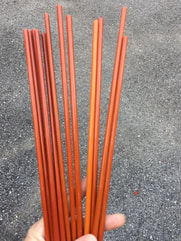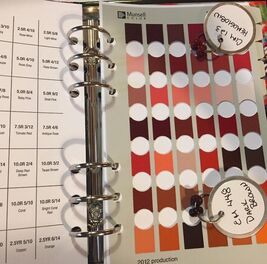Munsell's system for coding colors is a little like Pantone (something with which people are often more familiar, especially given the popular media stir created annually when they announce the Color of the Year). Munsell's was developed nearly a decade ago to create a guide to help classify soil samples by color. It takes into account hue (color), chroma (how intense it is) and value (how light or dark the color is). It is used in a variety of applications, but there are specific field guides that relate to archaeology, including the aforementioned guide for soils, and one for ceramics and one for glass beads. The last is the one that I find most interesting.
I learned about the guide when I was doing Viking Age bead research and stumbled across Matthew Delveaux's blog https://textandtrowel.wordpress.com/ He has a specific article about Viking Age glass colors (HERE) and wrote a piece housed on the Munsell site (HERE).
|
Basically, the Munsell Bead Book contains a set of color chips that you can lay your glass samples next to and compare the colors (it was meant to be used in natural light).
I have already noted the flaws in trying to replicate color based on some Birka samples (post can be found HERE), and that I know that different monitors show color differently (on top of the issues with the actual photography, quality of books, or scans), this system was nothing short of brilliant to me. Finally, a way to better understand the items I cannot see with my own eyes! Plus, I could make samples and charts of things!!! (And everyone knows this is really my favorite hobby!). This system immediately had my interest! |
|
I tracked down hard copies of two publications that had articles by Delveaux that labeled beads with the codes from this system, and used Inter Library Loan to get a copy of the bead guide itself (which was so cool I promptly ordered my own). I decided to make samples of all of my glass, and then apply Munsell codes and then lay them out in a graph that also has points on it for the colors that Delveaux categorized. So far I have done the warm colors (around 30 samples, though I have obtained a few more since then) and hopefully this winter I will have time to do the cool colors. |

- The book is insanely expensive. It IS available via ILL as I mentioned, but you would need to have all of your samples ready before getting it, I would think.
- Not everyone uses this system for categorizing colors. Delveaux did amazing work with the Viking Age beads he worked with (and also, if you want to totally freak out over an incredible data set, check this out.... https://dataverse.harvard.edu/dataset.xhtml?persistentId=doi:10.7910/DVN/RODUZG ). I think his work is the only Viking Age work I have seen. I have some English beads categorized like this and a few other papers here and there, but I really wish there were more that were relevant to my interests.
- Vision and color are funny things. Some people have a very limited range for color vision, while others can determine different colors in a similar set more readily. Education and understanding of color (which I fortunately have) also helps better interpret results. I feel it still give a good base starting place for my selecting colors.
- Certain glass colors can change over time (or being buried in certain conditions), so results can sometimes be off despite best efforts unless there happens to be a more recently broken sample where the inside can be categorized.
- Glass changes depending on the temperature at which you work it, how long you work it, how it is annealed, etc. Even buying standard glass colors can have a broad range between batches (the image to the right are all Effetre #444).


 RSS Feed
RSS Feed